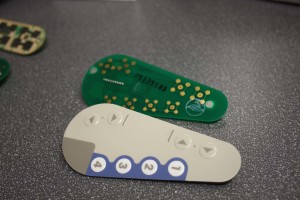A Definition of Non-Tactile PCB Membrane Switches
Non-tactile PCB membrane switches are membrane switches that do not provide direct feedback to users. Often, they use an LED indicator or some sort of a display change to provide alternative feedback to users, so they know the switch has been pressed and the connection has been made to initiate whichever event or action the switch controls. Non-tactile switches provide designers and engineers with the ability to easily create custom shapes and sizes of active keypad areas, though non-tactile and tactile switches may be mixed in the same PCB. Non-tactile PCB membrane switches typically are more reliable and economical membrane switch types than tactile switches are.
Features of Non-Tactile PCB Membrane Switches

- Embedded LED Non-Tactile PCB Membrane Switches – Embedded light diode emitting (LED) non-tactile PCB switches may incorporate single point and block
LEDs or integral/surface mounted single point LEDs. It is fairly simple to include an LED light source underneath a non-tactile PCB switch assembly integrated into the switch. Their thin form factor keeps the low profile of the non-tactile switch in tact. Multiple colors and even bi-colors are available for embedded LED non-tactile PCB switches. Benefits of LED non-tactile PCB switches include low cost, efficient power consumption, single or bi-color options, and a wide variety of sizes, colors, and intensities.
- Fiber Optic Backlighting for Non-Tactile PCB Membrane Switches – Some companies offer thin profile, flexible fiber optic backlighting panels that can be placed between elastomeric keypads or overlays and non-tactile PCB switches. Fiber optic backlighting offers more uniform backlighting across a broader area of the switch keypad. Advantages of fiber optic backlighting for non-tactile PCB switches include low power consumption (often adequately lit using a single LED), a long life (most configurations feature more than 100,000 hours), humidity resistant, replaceable, thin, no complex electrical drivers or inverters required, and no added heat or EMI to interfere with the non-tactile PCB switch operation.
- Electroluminescent Backlighting for Non-Tactile PCB Membrane Switches – Electroluminescent lighting (EL) contains phosphors. EL backlighting for non-tactile PCB switches is best used in low- to no-light applications when the backlight does not always need to be on, because the phosphors have a tendency to decay when use for extended periods of time at high voltages or frequencies. EL lighting allows for thin switch designs, low power consumption, and a typical life of 1,000 to 20,000 hours. One drawback of EL backlighting for non-tactile PCB switches is that they may require the use of a DC/AC inverter for power.
The features of non-tactile PCB switches make them a top choice for rugged environments and for customers who want to save a little money versus choosing tactile PCB switches. Typically, non-tactile PCB membrane switches are used in consumer devices, appliances, medical devices, light to medium industrial applications, and some aviation and marine applications.
Benefits of Non-Tactile PCB Membrane Switches

- Light weight
- Lower cost
- Low profile
- Dust resistant
- Moisture resistant
- Embedded lighting
- Easily incorporate into complex user interfaces
Another benefit of non-tactile PCB membrane switches is that they easily combine with other electronic interface components, resulting in cost-effective multi input/output (I/O) interfaces.

